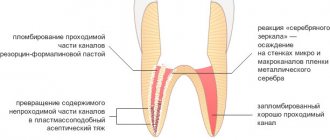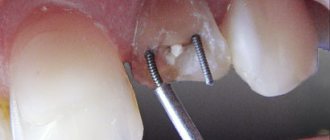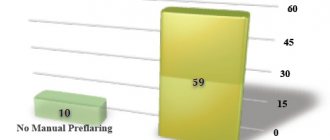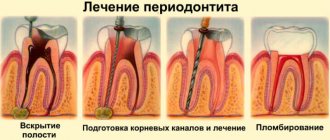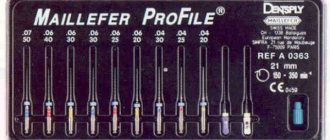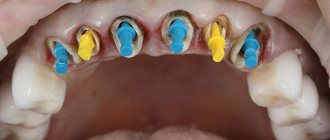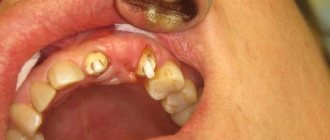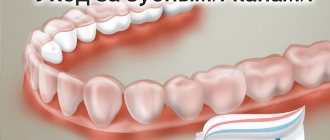Resorcinol-formalin method of root canal filling
This method involves the transformation of the pulp or its decay in the impassable part of the root canal into a plastic-like aseptic strand that is not subject to dissolution or decay under the influence of microflora and tissue fluid.
First, the carious cavity is prepared, the tooth cavity is opened and endodontic access is created. After this, the patency of the root canals is determined. Well-passable canals are mechanically and medicinally treated and sealed.
Pregnation with a resorcinol-formalin mixture is carried out in three to four visits. When carrying out the resorcinol-formaldehyde method, the contents of the root canal are impregnated with a resorcinol-formaldehyde mixture, which, after using a catalyst, polymerizes into phenol-formaldehyde plastic. As a result, the pulp, together with microorganisms, appears to be immured in this glass-like mass that does not decay. During the polymerization process, this mass shrinks, moving away from the canal walls and apical foramen, so the resorcinol-formalin method does not guarantee sealing of the canal lumen. To reduce shrinkage, the passable part of the canal should be filled with resorcinol-formalin paste.
After the resorcinol-formalin method, the tooth turns pink; when it penetrates the apical foramen, the resorcinol-formalin mixture causes irritation of periodontal tissue.
In 1912, Dr. Albrecht proposed a method of filling infected tooth canals using formaldehyde saturated with resorcinol (resorcinol is a phenol derivative). The method is based on the bactericidal and mummifying properties of this mixture, due to which the decay of incompletely removed pulp is stopped. The mixture slowly hardens in the tooth canals, which was thought to seal them. The method turned out to be cheap, easy to use and widely used. In our country, during Soviet times, it was used in the treatment of chewing teeth (molars) in 84% of cases, and continues to be used now by many dentists, symbolizing poor quality treatment in professional circles.
The fact is that many years of research have cast doubt on the effectiveness of the resorcinol-formalin method and have proven that its use is dangerous for the body . Formalin and resorcinol are toxic substances that have carcinogenic and mutagenic properties. Once in the canals of the tooth, formaldehyde (the active ingredient in formalin) gradually spreads throughout the body - it was found in the liver and kidneys, in the lungs, and in the muscles. It is quite possible that in many cases dangerous diseases were provoked by dental treatment using resorcinol-formalin. Therefore, all progressive dentists have unanimously said “no” to this method of treating root canals for more than 20 years.
For about ten years, the patient may not experience pain from the treated tooth, but this does not mean that everything is fine. The hidden inflammatory process continues, and cysts form on the roots of the tooth. Due to the toxic effect of the resorcinol-formalin mixture, the gums gradually atrophy, exposing the roots of the tooth. The result is that in 75% of cases repeated intervention is required. Retreatment or removal of such a tooth is associated with many difficulties . On x-rays, the “resorcinol-formalin” canals of the tooth appear empty, which makes diagnosis difficult. The tooth becomes brittle and begins to crumble . The color of the tooth always changes - it becomes pinkish or dark. Teeth do not whiten after treatment with the resorcinol-formalin method. As a result, the doctor who has to re-treat the tooth cannot guarantee a positive outcome even when using modern effective methods . And, the saddest thing is that “resorcinol-formalin” teeth, as a rule, cannot be used as a support for a prosthesis , and if you choose between a fixed bridge and a removable prosthesis, you will have to make a decision in favor of a removable prosthesis with all its inconveniences and disadvantages.
In Russia, the leaders of the Endodontic Section of the Dental Association decided not to recommend the resorcinol-formalin method for clinical use, and also to petition for its exclusion from the training program at dental faculties. However, this method is still used today. Its “survivability” is apparently due to the cheapness and low solvency of the majority of our fellow citizens, and, in addition, their unjustifiably indifferent and frivolous attitude towards their health. Therefore, when faced with the need for root canal treatment, always ask your dentist if he is going to use the resorcinol-formalin method. And if the answer is yes, we recommend finding another doctor.
(based on Internet sources)
-What analogues of this method of treating pulpitis and periodontitis are available in our clinic?
— One of the effective modern methods is the method of lateral condensation of gutta-percha. In the West, it is used to treat tooth canals in approximately 80% of cases.
The essence of the method is that the tooth canal, after removal of the pulp and mechanical treatment with special instruments, is filled with thin and flexible rods (pins) of gutta-percha in combination with a special hardening paste. Gutta-percha is the dried sap of the gutta-percha tree, which grows in Brazil and Malaysia. Plastic gutta-percha pins can be used to fill a tooth canal of any thickness and curvature; they do not collapse inside the canals. The paste, used in combination with gutta-percha pins, has an antiseptic effect and hermetically seals the tooth canal. All drugs used are non-toxic and do not irritate tooth tissue. So the treatment turns out to be quite effective and can significantly extend the life of the tooth.
Silver plating method for root canal filling
The silvering method involves soaking the impassable part of the root canal with silver nitrate. After the restoration of silver, a thin film of metallic silver (“silver mirror reaction”) is deposited on the walls of the micro- and macrochannels, “burying” the microflora in the thickness of the dentin. As a result of the interaction of silver with pulp proteins, silver albuminates are formed, which “preserve” the pulp, turning it into an aseptic strand that is not subject to putrefactive decay. In addition, the presence of silver in the canal, which has a long-term antiseptic (more precisely, oligodynamic) effect, prevents the growth of microflora and the development of inflammatory complications from the apical periodontium.
Impregnation using the silvering method is also carried out in 3-4 visits.
Combination of silvering method and resorcinol-formalin method
To increase the efficiency and reliability of impregnation methods, it was proposed to combine the silver plating method and the resorcinol-formalin method. In this case, the silvering method is first carried out, in which the walls of the micro- and macro-channels are covered with a film of metallic silver. Then impregnation is carried out with a resorcinol-formalin mixture, as a result of which the pulp in the impassable part of the root canal turns into an aseptic plastic-like strand that is not subject to dissolution or decay under the influence of microflora and tissue fluid.
What is the danger?
The main reason for such a long existence of the resorcinol filling method is its low cost, ease of use and effectiveness. But in many countries around the world this method is strictly prohibited and has not been used for more than 70 years. Dentists practicing today in European countries and the USA do not even know about its existence.
But, in the USSR, this method was the main one in the treatment of dental canals, and some dentists still use it. So why can’t resorcinol-formalin paste be used as a filling material for dental canals and pulp?
It's all about the composition of the paste. The formaldehyde and resorcinol it contains are hazardous toxins that have been proven by many years of research to have carcinogenic and mutagenic properties.
Formaldehyde, which is part of the filling agent, penetrates from the tooth canal into the blood and spreads throughout the body, reaching the kidneys, lungs, liver and other organs. When these substances settle in them, they can cause the development of cancer.
Another negative side of resorcinol-formalin is that a tooth, once treated with this substance, is practically not subject to re-treatment. As the practice of using this method shows, the paste does not always completely fill the dental canals. Therefore, there remains a risk of resumption of the inflammatory process in the hermetically sealed canal.
Cysts and ulcers form on the root of the tooth.
Almost 50% of cases of teeth treated with resorcinol require re-treatment, which cannot be performed for the following reasons:
- X-rays show canals filled with paste as voids, so there is no possibility of an accurate diagnosis, and, therefore, there is no confidence in the correct treatment strategy.
- After treatment with resorcinol, the tooth becomes pathologically brittle and crumbles under dental instruments;
- After resorcinol, it is impossible to fill the canal again, as hypercementosis develops - cement deposition in the root area. The root grows firmly into the bone, and filling it can cause serious complications, as well as removal.
Not only is treatment after resorcinol extremely problematic, but prosthetics using a resorcinol-formalin tooth is also impossible.
The fact is that fragile teeth, due to treatment with this method, cannot be used as a support for orthodontic dentures.
Mummification of the contents of the impassable part of the root canal
The term “mummification” in dentistry refers to the prevention of microbial decomposition of the pulp by impregnating it with potent antiseptics (thymol, camphor, iodoform, cresol, parachlorophenol, etc.). For this purpose, a cotton swab moistened with potent, slowly dissolving antiseptics, or a paste containing mummifying substances, is placed into the tooth cavity at the mouth of the root canals, and the tooth is sealed. This method is currently practically not used due to its low efficiency.
Resorcinol-formalin method or the story of one tooth. Patient's view.
N.I. KUDRYA, specialist of the medical standards department
Probably every person at least once in his life has had to deal with a toothache that does not go away for a minute, gets worse from hot, cold and becomes especially severe at night. This happened to me once too. I tried to relieve the pain with a pill. But neither after the first nor after the second pill the pain disappeared. After spending the night, I went to the dentist in the morning. The doctor diagnosed it as pulpitis.
Pulpitis is the result of penetration of pathogenic microbes into the dental pulp, causing its inflammation. Pulp is the loose soft tissue that fills the dental cavity, consisting of many nerves, lymphatics and blood vessels.
Sitting in the dental chair, I thought only about one thing - to quickly get rid of this torment. Then I didn’t even think about what method I would be treated with. At that time, pulpitis of chewing teeth was treated in one way. A paste containing arsenic was placed into the tooth pulp. The patient left only to return 2–3 days later. During this time, the paste killed the nerve, the tooth became insensitive. At the next visit, the dead pulp was removed, and the canals were filled with the resorcinol-formalin method. At the end, the doctor put a permanent filling, and the patient went home happy, which I did too.
Once, during a routine examination, the dentist recommended that I put a crown on that same tooth. I agreed. The doctor also advised me to treat the root canals to make sure that there are no inflammatory processes in them. To do this, it was necessary to unseal the canals, treat them instrumentally and medicinally, and seal them again. During the retreatment, I learned that my tooth had previously “tested” the resorcinol-formalin method. It turned out that it is now impossible to properly treat the canals. The paste that was in the tooth cavity has turned into a solid mass that cannot be passed through with an instrument. In the end, the tooth was “crowned” with a crown with no guarantee that future complications would not arise.
I wanted to know more about the resorcinol-formalin method. At that time, not being a doctor by training, I was already working in a dental center and could get information from personal conversations with specialists.
The method of filling canals using formalin saturated with resorcinol was proposed in 1912 by Dr. Albrecht. According to the author, the mixture had bactericidal and mummifying properties. Followers began to believe that the mixture solidified in the channels, reliably sealing them. For that time it was a truly progressive method, because... It became possible to save diseased teeth - previously they were simply removed. In addition, it turned out to be inexpensive and quite easy to use, which also played a role in its wide distribution.
Today, practice shows that resorcinol-formalin paste does not always completely fill the canals, and this can be seen on x-rays. Foci of inflammation remain, which leads to complications and the need to re-treat the tooth. The retreatment process is quite complex and not cheap for the patient. In addition, the likelihood that retreatment will be successful is low. There is also an aesthetic drawback - the “resorcinol-formalin” tooth acquires a pinkish-brown tint. In addition, the dangers of using the resorcinol-formalin method have been proven by many years of research. Formaldehyde and resorcinol are toxic substances. Formaldehyde, the active ingredient in formalin, gradually spreads throughout the human body and has a negative effect on the reproductive organs, central nervous system, respiratory tract, skin, and eyes.
In many countries around the world, the use of the resorcinol-formalin method in dentistry is prohibited. For example, in Switzerland it has not been used for more than 70 years. In the United States, a doctor who offers this method to a patient is deprived of his license. In our country, some municipal dental clinics still use the resorcinol-formaldehyde method of root canal treatment, despite the fact that safer and more reliable methods exist. The reason for its indestructibility is the same cheapness and the lack of opportunity or desire among Russians to pay for high-quality dental treatment.
It often happens that a person is faced with the need to make a choice that is difficult to make correctly without having the necessary information, especially when it comes to health. In this article, I wanted to talk about the resorcinol-formaldehyde method, without using medical terms, from the perspective of a patient who has experienced the consequences of its use. I hope I succeeded.
